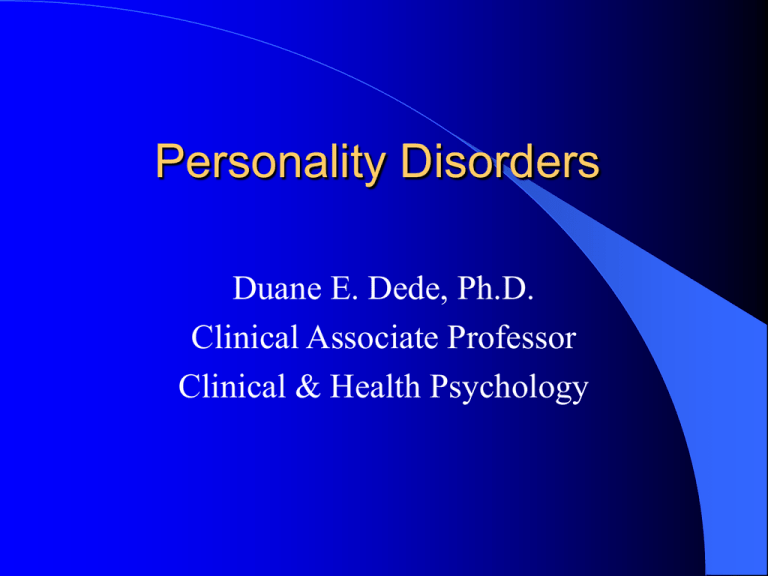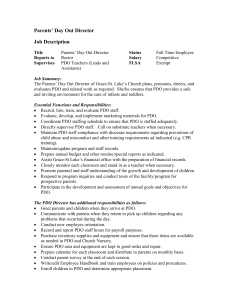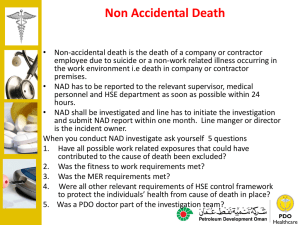
Personality Disorders
Duane E. Dede, Ph.D.
Clinical Associate Professor
Clinical & Health Psychology
Under
stress…our
personalities become
emphasized
Sources of Information
History
Behavioral
Observations
Test
Results
Personality Disorders
Chronic behavioral disturbance with early
and insidious onset that crystallize by late
adolescence or early adulthood
Behavior patterns are inflexible and
maladaptive
Goal-discover how a pt’s personality
interacts with the stress of illness or is
manifested across situations
PDO’s continued
Because these behavior patterns are so
ingrained, the PDO frequently only present
when in Axis I crisis
Quantitative difference-PDOs lead to
impairment in occupational/interpersonal
functioning (transcends the situation)
PDO’s General Tx Guidelines
Goals should be realistic
Goals should be relevant to the situation
PDO’s are life-long patterns that will not
change in short intervention.
– Inpatient setting-”Play to strengths”
Initial goals may only be some Sx
improvement and increased awareness
Cluster A PDOs
“Odd & Eccentric Behavior”
Paranoid PDO-a pattern of distrust &
suspiciousness such that other’s motives are
interpreted as malevolent.
Schizoid PDO-a pattern of detachment from social
relationships & a restricted range of emotional
expression
Schizotypal PDO- a pattern of acute discomfort in
close relationships & restricted range of emotional
expression.
Paranoid PDO
Derek worked in a large office as a computer programmer. When
another programmer received a promotion, Derek felt that the
supervisor "had it in for him" and would never recognize his worth. He
was sure that his co-workers were subtly downgrading him. Often he
watched as others took coffee breaks together and imagined they spent
this time talking about him. If he saw a group of people laughing, he
knew they were laughing at him. He spent so much time brooding
about the mistreatment he received that his work suffered and his
supervisor told him he must improve or receive a poor performance
rating. This action reinforced all Derek's suspicions, and he looked for
and found a position in another large company. After a few weeks on
his new job, he began to feel that others in the office didn't like him,
excluded him from all conversations, made fun of him behind his back,
and eroded his position. Derek has changed jobs six times in the last
seven years.
Paranoid PDO
Excessive sensitivity to setbacks and rebuffs
Bears long-term grudges (refuses to forgive)
Suspiciousness and pervasive distrust by misconstruing the
neutral or friendly actions of others as hostile
Combative and tenacious sense of personal rights beyond
what seems to be appropriate
Recurrent suspiciousness, without justification about
fidelity of spouse or sexual partner
Excessive sense of self-importance
Preoccupation with unsubstantiated conspiratorial
explanations of event (personal or otherwise)
“Geriatric Paranoia”
Schizoid PDO
Few pleasurable activities (less desire than APDO)
Emotionally cold and detached with flattened affect
Limited capacity (or desire) to express warm, tender or
angry feelings toward others
Indifferent to praise or criticism
Little interest in sexual relationship with other
Consistent choice of solitary activities
Excessive preoccupation with fantasy & introspection
No desire for close relationships (“only one”)
Insensitive to prevailing social norms & conventions
Schizoid PDO Tx
Medication & Psychotherapy
Blackmon (94)
– A schizoid young man made a methodical attempt at suicide. He
revealed a paucity of object attachments leading to profound
isolation. His early upbringing led him to extreme isolation of
affect and a fear of fragmentation. His inner life was not safely
reachable by conventional therapy. After he became involved in
playing a fantasy game, dungeons and Dragons, the therapy was
modified to use the game material as displaced, waking fantasy.
This fantasy was used as a safe guide to help the patient learn to
acknowledge and express his inner self in a safe and guided way.
The patient ultimately matured and developed healthier object
relations and a better life.
Schizotypal PDO
Ideas of reference (excluding delusions of reference)
Odd beliefs or magical thinking that influence behavior
and are inconsistent with sub-cultural norms
Unusual perceptual experiences, including bodily illusions
Odd thinking and speech (vague, metaphorical,
overelaborate or stereotyped)
Inappropriate or constricted affect
Odd, eccentric or peculiar behavior or appearance
Lack of close friends or confidants, other than relatives
Excessive social anxiety that does not diminish with
familiarity and tends to be associated with paranoid fears
rather than negative self judgements
Schizotypal PDO
Strong genetic contribution
– Consequently, late-onset schizophrenia is more frequent
and more severe in women than in men.
– The sex difference in age of onset is smaller in cases
with a high genetic load and greater in cases with a low
genetic load.
– Type of onset and core symptoms do not differ between
the sexes. The most pronounced sex difference is the
socially negative illness behavior of young men.
– Negative Schizophrenic Sx associated with ScPDO in
family members
Schizotypal PDO Tx
ScPDO patients with prominent cognitive/perceptual
distortion may respond to neuroleptic agents. The most
salient example of this is the testing of serotonin-specific
agents (e.g., fluoxetine) for potential antiaggressive
efficacy in personality disordered subjects with prominent
histories of impulsive aggressive behavior.
Psychotherapy is difficult and may be cyclic around times
of medication non-compliance. Focus is on stability,
reality testing and improving coping mechanisms
Case Example
42 year-old African-American woman with
chronic history of attention and concentration
difficulties-presented for ADHD evaluation
Presentation/Family History
Results:
– IQ, language and memory intact; mild executive
dysfunction. Poor coping typified by isolation, anxiety,
ruminative thinking and social introversion
Cluster C PDO’s
“Anxious and Fearful Behavior”
Avoidant PDO-Social inhibition, inadequacy
feelings, & hypersensitivity of negative evaluation
Dependent PDO-Pervasive & excessive need to be
taken care of that leads to submissive & clinging
behavior and fears of separation
Obsessive Compulsive PDO-Preoccupation with
orderliness, perfectionism and mental &
interpersonal control, at the expense of flexibility,
openness, and efficiency.
Avoidant PDO’s
Avoids activities with significant interpersonal contact,
because of fears of criticism, disapproval or rejection
Unwilling to become involved without “guarantees of
acceptance”
Very restrained in intimate relationships due to fear of
shame or ridicule
Preoccupied with social criticism or rejection
Inhibited in new interpersonal situations
Views self as socially inept, personally unappealling or
inferior to others
Very reluctant to take personal risks
Avoidant PDO continued
Desire close relationships, but too shy and
insecure to obtain (persevere) them
Very frustrated by their inability to relate
Will try to prevent rejection by ingratiating
themselves to others
Contrasted to Social Phobias, APDO fear all
social situations
Avoidant PDO Treatment
Assertiveness training, group therapy (with
care to limit confrontation early in tx.)
Cognitive Behavior-focus on hierarchy and
creating early success, normalize fears
Risks
– pushing too fast
– too restrictive
Dependent PDO
Significant indecision without excessive advice or
reassurance from others
Needs others to be responsible for most major
areas of his/her life
Rarely disagrees due to fear of disapproval
Rarely initiate projects or doing things alone due
to poor self-confidence, instead of low motivation
Goes to excessive length to obtain nurturance and
support from others (volunteering for unpleasant
tasks)
Dependent PDO continued
Feel uncomfortable or helpless when alone due to
exaggerated fear of being unable ot care for self
Urgently seeks another relationship as a source of care and
support when a close relationship ends (most common
reason for entering tx.)
Unrealistically preoccupied with fears of being left to take
care of himself or herself (“dreads autonomy”)
Productive when supervised, otherwise see themselves as
“inept or stupid”
When pressed to name redeeming qualities, will reluctantly
confess to being “good companion, loyal & kind”
Other DPDO characteristics
Freud-Oral characteristic-intense need to be
fed or taken care of.
Common in normal clinic situations, but
very high in psychiatric patients
Common with other PDO’s and Axis I D/Os
such as Agoraphobia
Gender?
Dependent PDO Tx
Short term-Group Therapy & Assertiveness
Training
Psychodynamic (Maxem)
– origins of low self-esteem
– fears of harming others by seeking autonomy (e.g.
assigned to spend time alone)
– dependency on the therapist
– termination a key part of therapy
– Countertransference-guilt and anger
Obsessive Compulsive PDO
How does it differ from OCD?
– Some comorbidity, but OCPD rarely develops OCD
Four or more of the following:
– Preoccupied with details, rules, lists, order, organization
and schedules
– Perfectionism interferes with task completion
– Excessively devoted to work and productivity
– Overconscientious and inflexible about morals, ethics
& values
OCPD criteria continued
Unable to discard worthless objects
Aversive to delegating tasks
“Miserly spending”-money is to be hoarded
for catastrophes
Stubborn and rigid traits
Descriptors
– Miss the forest for the trees; difficult seeing
other’s perspectives; avoids “soft feelings”
Epidemiology
Prevalence (all existing cases @ one point in time)
– 1% in community samples
– Adult lifetime prevalence 2.5%
– 3-10% in mental health clinics
Gender differences
– Males are twice as likely as females
History
Freud’s (1908) Anal character
– Orderly, obsessed with bodily cleanliness,
conscientious to the utmost, obstinate
Abraham (1921) expanded on this:
– Discussed the pleasure of ordering things
DSM-I & DSM-II highlighted orderliness
DSM-III, III-R added some symptoms
DSM-IV (TR) require 4 of 8
Treatment
Medications:
– Contrary to OCD, very little consistent
evidence of benefit from pharmacotherapy
Psychotherapy-very effective
– CBT targets maladaptive schemas,
automatic/distorted thoughts, and impact of
family background/expectations
Consider the cultural background of client
Cluster B PDOs
Dramatic, emotional or erratic behavior
Antisocial PDO-Pervasive disregard for &
violation of the rights of others
Borderline PDO-Pervasive instability of
interpersonal relationships, self-image & affect
Histrionic PDO-Excessive emotionality &
attention seeking
Narcissistic PDO-Pervasive grandiosity (fantasy &
behavior), need for admiration & lack of empathy
Antisocial PDO
Pervasive pattern of disregard for and
violation of rights of others, occurring since
age 15, as indicated by 3 (or more) of:
– Failure to conform to social norms with respect
to lawful behaviors as indicated by repeated
arrest.
– Deceitfulness (repeated lying, use of aliases or
conning others for personal profit or pleasure)
Antisocial PDO continued
Impulsivity or failure to plan ahead
Irritability and aggressiveness, as indicated by repeated
physical fights or assaults
Reckless disregard for safety of self/others
Consistent irresponsibility, as indicated by repeated failure
to sustain consistent work behavior or honor financial
obligations
Lack of remorse
18 years of older; Evidence of a Conduct DO <15
Antisocial behavior not exclusively during SCz of Mania
Antisocial PDO continued
Radar for people’s vulnerabilities; enjoy manipulating,
exploiting and intimidating others.
Crave stimulation (drugs, manipulation, sex) to medicate
boredom or depression. Frontal lobe abnormalities*
Sexual relationships are thrilling conquests and nothing
more.
Emotionally shallow, incapable of shame, guilt, loyalty,
love and sincere emotion. Yet, quick to anger.
30-80% are in prison; Only 2% remit by age 21
3% of men & 1% of women in general population;
3-15% in psychiatric populations
Antisocial PDO Treatment
Extremely difficulty to treat and often
“ordered” into treatment by court*
Prevention is most effective, therefore
detection of AsPDO early is important
Family therapy is critical for patient and
especially the family
Treat co-morbid substance abuse
Borderline PDO
Intense fear of real/imagined abandonment
Intense, unstable interpersonal relationships that alternate between
idealization & devaluation
Marked disturbance of identity/self-image
Self-damaging impulsivity in at least 2 areas (sex, spending, substance
abuse, reckless driving, binge eating)
Recurrent suicidal behavior, gestures, threats or self-mutilating beh.
Affective instability due to marked reactivity of mood
Chronic feelings of “emptiness”
Inappropriate, intense anger or difficulty modulating anger (frequent
displays of temper, constant anger or physical fights)
Transient, stress related paranoid ideation or severe dissociative Sx.
Prevalence: Women: Men (2:1)
Borderline PDO continued
Label initially referred to straddling the border between
neurosis and psychosis (“latent schizophrenia”)
Identity confusion is often manifested as dissociation
Often “present well” but turmoil very evident in
interpersonal relationships
Anything less than total love is hate; anything less than
total commitment is rejection (rejection sensitivity)
Expect & demand others to do what they can’t do for
themselves
Chronically sad and demoralized which lead to
presentation of neurotic Sx (anxiety, mood d/o &
conversion Sx.) that become psychotic under stress
Bizarre responses on structured & unstructured tests
Borderline PDO Treatment
Treatment is very difficult and marked by a series of goals
from safety/stabilization to interpersonal consistency
M. Linehan-Dilectical Behavior Therapy
Therapy is long-term, demanding, marked by frequent
hospitalizations and reality testing
Strong contertransference reactions, which often benefit
from consultation with peers
Pharmacotherapy-MAOs, SSRIs (anger, impulsiveness)
with Lithium/Dilantin used in severe cases
Histrionic PDO
Uncomfortable if not center of attention
Interactions are characterized by inappropriate sexually
seductive or provocative behavior
Rapidly shifting and shallow expression of emotions
Consistently uses physical appearance to draw attention to
him/herself
Impressionistic style of speech, which lacks detail
Self-dramatizing, overlytheatrical and exaggerated
expression of emotions
Suggestible & easily influenced by others/circumstances
Considers relationships more intimate than they are
Histrionic PDO continued
Formerly known as Hysterical PDO
Depicts worst stereotypes, Female-vain, vapid & vague
Male stereotypes: Superficial, demanding, inconsiderate,
self-indulgent, macho & preoccupied with their looks
Suicidal threats are gestures and are frequently attempts to
manipulate, rarely fatal unless by accident
Actor/Actress- “always on stage” Difficult to know when
they are actually upset since exaggeration is the norm
Tend to think in impressions contrasted to OCPD which
think in facts
Histrionic PDO Treatment
Increase awareness- Tend to be insecure & hypersensitive
to rejection by others, therefore use manipulation,
dependence or seduction in an attempt to obtain love,
acceptance or reassurance.
Countertransference-Seduced, overly involved or
indifferent (which may be perceived as rejection)
Behavioral Therapy-reward system where attention is
contingent on appropriate behavior
Groups-focus on learning how to share the spotlight
Psychodynamic-focus on the relationship
Narcissistic PDO
Grandiose sense of self-importance, often unwarranted
Preoccupied with fantasies of unlimited success, power,
brilliance, beauty or ideal love
Believes that s/he is “special” and can only be understood
by other high-status people
Requires excessive admiration
Entitled sense and expects special treatment
Interpersonally exploitative
Lacks empathy; Unwilling to recognize others feelings
Envious of others, believes others are envious of him/her
Arrogant behaviors or attitudes
Intolerant of criticism because of low self-esteem
More prevalent in men
Narcissistic PDO Treatment
Difficult to enter treatment because it is often perceived as
a sign of weakness (needing someone else)
Frequently enter therapy after suffering a Narcissistic
injury and are at risk for leaving treatment prematurely as
the dust settles.
Goal of treatment is to gain more realistic view of self
Behavioral Therapy-expose patient to anxiety of feeling
less than great (systematically)
Cognitive Therapy-discuss the paradox, realizing that no
achievement is enough
Countertransference-work very hard to please the patient
and therefore earn respect, leading to anger and battles
Questions?







